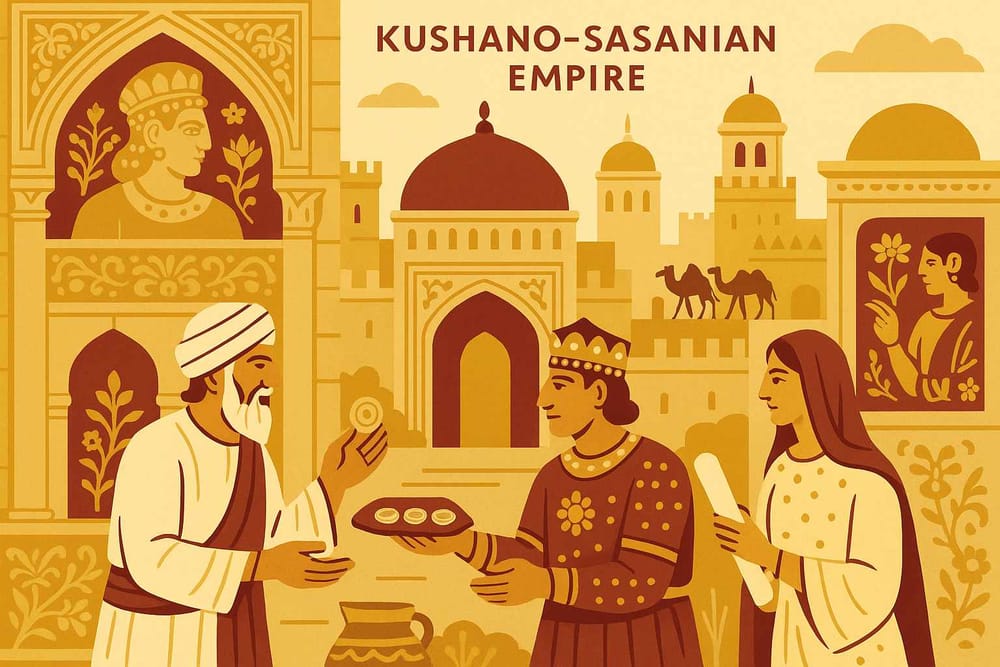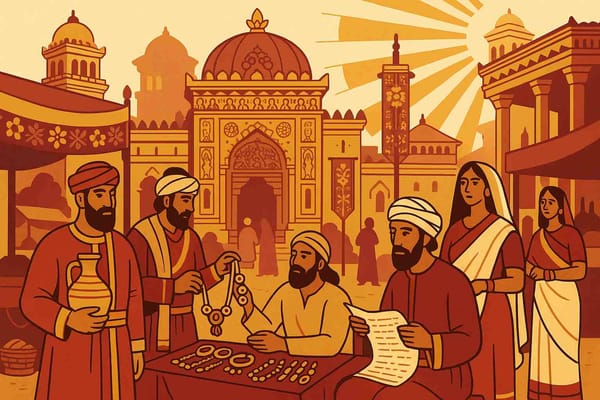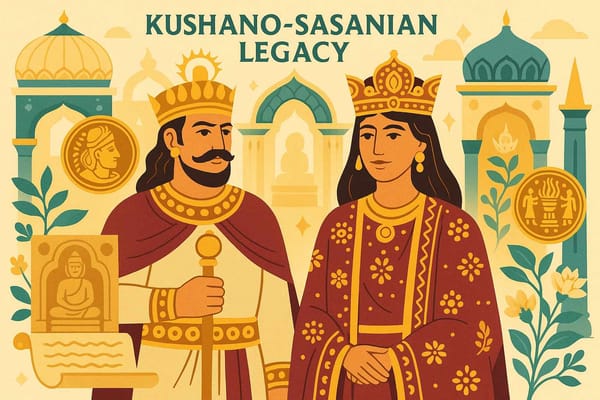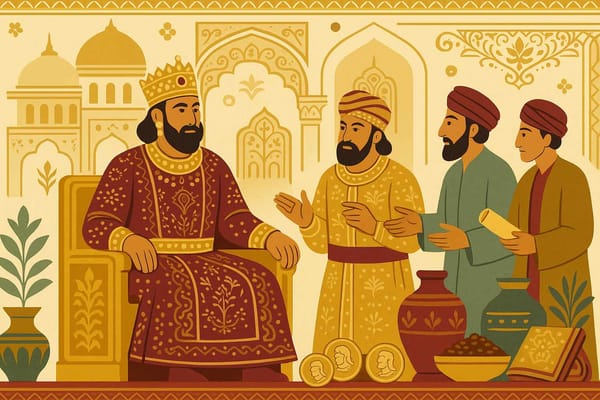
Exploring the Kushano-Sasanians- Ancient Empires Rise and Fall
Have you ever stood at a sangam, where two mighty rivers meet and merge into one? History has its own sangams, moments in time where great cultures flow into each other, creating something entirely new and powerful. Today, let's journey back to one such confluence, to a kingdom that has been largely forgotten but whose story is woven deep into the fabric of ancient India and Persia: the Kushano-Sasanian empire.
This isn't just a tale of kings and conquests; it's a story of art, faith, and a unique identity forged in the heart of Central Asia. It’s a chapter of our shared past that deserves to be remembered.
When Two Giants Met: The Birth of a New Power
Imagine the scene: in the 3rd century CE, the glorious Kushan Empire, which had ruled over large parts of northern India and Central Asia, was slowly losing its grip. At the same time, a new, ambitious power was rising in Persia—the Sasanian Empire. Led by the formidable king Ardashir I and his son Shapur I, the Sasanians began to expand eastward.
But this wasn't just a simple takeover. Instead of erasing the Kushan legacy, the Sasanians did something remarkable. They established a sub-kingdom in the lands of Bactria, Sogdia, and Gandhara. The Sasanian nobles appointed to rule these areas took on the title "Kushanshah," meaning "King of the Kushans." It was a sign of respect, an acknowledgement of the people and culture they now governed. This was the birth of the Kushano-Sasanians, a new dynasty with Persian roots and a Kushan heart.
A Bridge Between Worlds: Art, Faith, and Life
The land ruled by the Kushano-Sasanians became a vibrant melting pot. Great cities like Balkh and Gandhara, already hubs of culture, buzzed with new energy. This was a place where different worlds didn't just coexist; they conversed and created together.
This unique fusion is beautifully captured in their legacy. People often ask, what were the Kushano-Sasanians truly known for? The answer lies in their incredible ability to blend traditions.
- A Harmony of Faiths: Imagine walking through their cities. You might see a Zoroastrian fire temple, its eternal flame flickering, not far from a serene Buddhist monastery or a temple where Lord Shiva and Nandi were revered. Their coins are a testament to this harmony, with some depicting a Sasanian-style fire altar on one side, and Shiva with his bull Nandi on the other. It shows a deep understanding and respect for the diverse beliefs of their people.
- Art That Tells a Story: The art from this period is simply breathtaking. It’s a beautiful conversation between the grand, imperial style of the Sasanians and the spiritual, humanistic art of Gandhara. This syncretic art wasn’t just a mix; it was a new language that expressed the soul of this hybrid empire.
Guardians of the Silk Road
The Kushano-Sasanian kingdom was strategically located right on the Silk Road, the ancient highway of trade and ideas. They weren't just passive observers; they became its guardians and key players. They understood that their prosperity was tied to the safety and flow of the caravans that snaked through their lands, carrying silk from China, spices from India, and Roman glass from the West.
To ensure this, they maintained secure routes and issued their own distinct coinage. Their silver drachms, featuring portraits of their rulers and symbols from both cultures, became a trusted currency. These coins weren't just money; they were a symbol of the stability and economic vibrancy the Kushano-Sasanians brought to the region, making them a vital link in the ancient global economy.
The Unraveling of a Golden Tapestry
Like all great empires, the Kushano-Sasanian story also has its chapter of decline. Their strength, born from a union, was also their vulnerability. Internal tensions sometimes flared up, like the rebellion led by Hormizd I Kushanshah against his Sasanian overlord, a sign of the complex power dynamics at play.
The bigger challenge, however, came from outside. Around the 4th century CE, new waves of invaders, the Kidarites and later the Hephthalites (also known as the Alchon Huns), swept in from the north. These fierce warriors dismantled the Kushano-Sasanian power structure, conquering their territories. Though the Sasanians tried to regain control, their golden age in this region was over. Internal conflicts and relentless external pressures eventually led to the fall of this dynamic empire, paving the way for new powers to rise.
Whispers in Time: The Lasting Legacy
So, why is the story of this forgotten empire so important today? Because their legacy is all around us, in the whispers of history. The art they nurtured influenced styles across Central Asia for centuries. Their experiment in cultural and religious tolerance is a timeless lesson. They remind us that our history is not a straight line but a rich, interwoven tapestry.
Learning about the Kushano-Sasanians helps us understand the deep, ancient connections between India, Persia, and Central Asia. Their story is a beautiful testament to how collaboration and mutual respect can create something truly magnificent.
About Us
At Bhaktilipi, we believe every story from our past matters. We are a digital space dedicated to preserving and sharing the timeless devotional literature and cultural histories that shape our identity. We strive to make these profound narratives accessible for today's generation, connecting us to our rich heritage.
Why Explore Ancient Empires on Bhaktilipi?
Understanding empires like the Kushano-Sasanians is about more than just history; it's about understanding the roots of our traditions, art, and faith. On Bhaktilipi.in, we bring you curated stories and insights that illuminate our past, helping you connect with the incredible journey of our civilization.
Stay Connected
Join our community of culture and history enthusiasts! Subscribe to our newsletter for more inspiring stories and follow us on Facebook, Instagram, and YouTube for a daily dose of spiritual and cultural enrichment.
Final Thoughts
The rise and fall of the Kushano-Sasanian Empire is a powerful reminder of the dynamic interplay between culture, power, and commerce in the ancient world. Their story is not just a relic of the past but an inspiring example of how diversity can be a source of incredible strength and creativity. By remembering them, we honor the shared heritage that binds us all across borders and through time.
A passionate group of people dedicated to preserving India's knowledge of Dharma, Karma, and Bhakti for ourselves and the world 🙏.
Comments
Related in

The Kushano-Sasanians- Explore the Empire's Secrets
Sometimes, the most fascinating stories of our motherland are not the ones we learn in school. We talk endlessly about the Mauryas, the Guptas, and the Mughals, but history has countless hidden chapters, tucked away in the sands of time. One such incredible tale is that of the Kushano-Sasanians, an

Exploring the Legacy of the Kushano-Sasanians: History and Impact
History isn't always about grand battles and massive empires that we read in school textbooks. Sometimes, the most beautiful chapters are written in the quiet spaces in between, where cultures meet, shake hands, and create something entirely new. Imagine a time when the powerful Persian Sasanian empire extended

Kushano-Sasanians- A Forgotten Era of History Explained
History, as we often read it, is a grand narrative of mighty empires and legendary conquerors. But sometimes, the most fascinating tales are hidden in the folds, in the chapters that speak not of conquest, but of confluence—a beautiful sangam of cultures. One such forgotten story is that of
